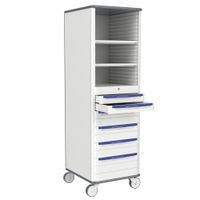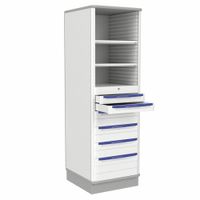Call +(254) 703 030 000 / 751 483 999 / 721 704 777
- Home
- Safety
- Medical Supplies Equipment
- Exam Room Furnishings
- Medical Cabinets
.....Read More
Frequently Asked Questions
What are the benefits of using medical cabinets in healthcare settings?
Medical cabinets in healthcare settings offer numerous benefits:
1. **Organization**: They provide a structured way to store medical supplies, ensuring that items are easy to find and access, which enhances workflow efficiency.
2. **Space Optimization**: Cabinets maximize the use of available space, allowing for more storage in compact areas, which is crucial in busy healthcare environments.
3. **Security**: Lockable cabinets protect sensitive items such as medications and patient records from unauthorized access, ensuring compliance with regulations like HIPAA.
4. **Inventory Management**: Cabinets with transparent doors or labeling systems help in maintaining accurate inventory levels, reducing waste and ensuring timely reordering of supplies.
5. **Infection Control**: Proper storage in cabinets helps maintain a sterile environment by protecting supplies from contamination, which is vital for patient safety.
6. **Accessibility**: Cabinets can be customized to meet specific needs, such as height adjustments or specialized compartments, making it easier for staff to access necessary items quickly.
7. **Durability**: Made from materials like stainless steel or high-grade plastics, medical cabinets are designed to withstand the rigors of a healthcare setting, ensuring longevity and reliability.
8. **Aesthetics**: Well-designed cabinets contribute to a clean and professional appearance, which can enhance the overall environment for both patients and staff.
9. **Compliance**: They help healthcare facilities meet regulatory standards for storage and handling of medical supplies, which is essential for accreditation and legal compliance.
10. **Cost-Effectiveness**: By improving organization and reducing waste, medical cabinets can lead to cost savings over time, making them a valuable investment for healthcare facilities.
How do you choose the right medical cabinet for a specific healthcare facility?
To choose the right medical cabinet for a specific healthcare facility, consider the following factors:
1. **Purpose and Functionality**: Determine the primary use of the cabinet. Is it for medication storage, medical supplies, or equipment? This will guide the type and design needed.
2. **Size and Capacity**: Assess the volume of items to be stored. Ensure the cabinet can accommodate current needs and potential future expansion.
3. **Material and Durability**: Choose materials that are easy to clean, durable, and resistant to chemicals and moisture. Stainless steel and high-quality plastics are common choices.
4. **Security Features**: For medication storage, ensure the cabinet has secure locking mechanisms to prevent unauthorized access. Consider electronic locks for added security.
5. **Compliance and Standards**: Ensure the cabinet meets healthcare regulations and standards, such as those set by OSHA or the Joint Commission.
6. **Accessibility and Ergonomics**: Ensure the cabinet design allows for easy access to contents, with adjustable shelves and ergonomic features to reduce strain on staff.
7. **Mobility**: Decide if a stationary or mobile cabinet is needed. Mobile cabinets offer flexibility and can be moved as needed.
8. **Space and Layout**: Consider the available space in the facility. The cabinet should fit comfortably without obstructing movement or workflow.
9. **Aesthetics and Design**: While functionality is key, the cabinet should also complement the facility's design and environment.
10. **Budget**: Balance quality and cost. Consider long-term value over initial expense.
11. **Vendor Reputation and Support**: Choose a reputable supplier who offers good customer support and warranty services.
By evaluating these factors, you can select a medical cabinet that meets the specific needs of your healthcare facility efficiently.
What materials are commonly used in the construction of medical cabinets?
Medical cabinets are typically constructed using materials that ensure durability, hygiene, and ease of maintenance. Common materials include:
1. **Stainless Steel**: Known for its strength, corrosion resistance, and ease of cleaning, stainless steel is often used in medical environments. It is non-porous, which prevents bacteria and germs from penetrating the surface.
2. **Laminate**: High-pressure laminate (HPL) is frequently used for cabinet surfaces. It is durable, resistant to scratches and stains, and available in various colors and patterns, allowing for aesthetic flexibility.
3. **Powder-Coated Metal**: This material offers a durable finish that is resistant to chipping, scratching, and fading. It is often used for the structural components of cabinets.
4. **Glass**: Tempered glass is sometimes used for cabinet doors or shelves. It is strong, easy to clean, and allows for visibility of stored items, which is useful for quick identification.
5. **Wood and Wood Veneer**: While less common in sterile environments, wood and wood veneer can be used in areas where aesthetics are prioritized. They are often treated with antimicrobial finishes to enhance hygiene.
6. **Plastic and Acrylic**: These materials are lightweight, resistant to chemicals, and easy to clean. They are often used for drawer liners or small components within the cabinet.
7. **Aluminum**: Lightweight and resistant to corrosion, aluminum is sometimes used for cabinet frames or components. It is less durable than stainless steel but offers a good balance of strength and weight.
These materials are chosen based on their ability to withstand the rigorous cleaning protocols required in medical settings, their resistance to chemicals and moisture, and their contribution to maintaining a sterile environment.
How do mobile medical cabinets differ from stationary ones?
Mobile medical cabinets differ from stationary ones in several key aspects:
1. **Mobility**: Mobile cabinets are equipped with wheels or casters, allowing them to be easily moved around different areas within a healthcare facility. Stationary cabinets are fixed in place and cannot be moved without significant effort.
2. **Flexibility**: Mobile cabinets offer greater flexibility in terms of usage and placement. They can be relocated to where they are needed most, such as different patient rooms or departments, whereas stationary cabinets are limited to a single location.
3. **Design and Structure**: Mobile cabinets are often designed to be more compact and lightweight to facilitate easy movement. They may have features like handles or brakes to ensure stability when stationary. Stationary cabinets can be larger and more robust, as they do not need to be moved.
4. **Functionality**: Mobile cabinets are typically used for tasks that require frequent relocation, such as emergency response, bedside care, or transporting supplies. Stationary cabinets are used for long-term storage and organization of medical supplies and equipment.
5. **Capacity**: Stationary cabinets often have a larger storage capacity due to their fixed nature, allowing for more extensive organization of supplies. Mobile cabinets may have limited space to maintain maneuverability.
6. **Security**: Mobile cabinets may include locking mechanisms to secure contents during transport. Stationary cabinets can have more advanced security features due to their fixed position.
7. **Cost**: Mobile cabinets can be more expensive due to the additional features required for mobility, such as durable wheels and lightweight materials. Stationary cabinets may be more cost-effective for permanent storage solutions.
8. **Usage Context**: Mobile cabinets are ideal for dynamic environments where quick access and adaptability are crucial. Stationary cabinets are suited for stable environments where supplies need to be consistently available in a fixed location.
What are the best practices for organizing supplies in medical cabinets?
1. **Categorization**: Group supplies by category (e.g., wound care, medications, diagnostic tools) to streamline access and restocking.
2. **Labeling**: Clearly label shelves and bins with the contents and expiration dates to facilitate quick identification and inventory checks.
3. **FIFO System**: Implement a First-In, First-Out system to ensure older supplies are used before newer ones, minimizing waste due to expiration.
4. **Accessibility**: Place frequently used items at eye level and within easy reach, while less commonly used supplies can be stored higher or lower.
5. **Standardization**: Use uniform storage containers and labels to maintain consistency and reduce confusion.
6. **Inventory Management**: Regularly conduct inventory checks to maintain optimal stock levels and reorder supplies as needed.
7. **Cleanliness**: Keep cabinets clean and organized to prevent contamination and ensure a sterile environment.
8. **Emergency Supplies**: Designate a specific area for emergency supplies, ensuring they are easily accessible and well-stocked.
9. **Security**: Secure medications and sensitive items in locked cabinets to prevent unauthorized access.
10. **Training**: Educate staff on the organization system to ensure compliance and efficiency in locating and restocking supplies.
11. **Ergonomics**: Arrange supplies to minimize bending, reaching, and lifting, reducing the risk of injury.
12. **Technology Integration**: Utilize inventory management software or barcode systems for efficient tracking and management of supplies.
13. **Regular Audits**: Conduct periodic audits to assess the organization system's effectiveness and make necessary adjustments.
14. **Space Utilization**: Maximize storage space with adjustable shelving and stackable bins to accommodate varying supply sizes.
How do you maintain and clean medical cabinets to ensure hygiene?
1. **Regular Cleaning Schedule**: Establish a routine cleaning schedule, ensuring daily cleaning of high-touch surfaces and weekly deep cleaning.
2. **Use of Appropriate Disinfectants**: Utilize hospital-grade disinfectants approved by health authorities. Follow manufacturer instructions for dilution and contact time.
3. **Personal Protective Equipment (PPE)**: Wear gloves, masks, and other necessary PPE to protect against exposure to cleaning agents and contaminants.
4. **Surface Cleaning**: Wipe down all surfaces, including handles, shelves, and doors, with disinfectant wipes or solutions. Pay special attention to corners and crevices.
5. **Inventory Management**: Regularly check expiration dates and remove expired or unused items. Organize supplies to prevent overcrowding and ensure easy access.
6. **Spill Management**: Immediately clean any spills using appropriate spill kits to prevent contamination and accidents.
7. **Ventilation**: Ensure proper ventilation in the cabinet area to reduce the buildup of fumes from cleaning agents and maintain air quality.
8. **Labeling and Signage**: Clearly label all shelves and storage areas to prevent cross-contamination and ensure quick access to necessary items.
9. **Staff Training**: Train staff on proper cleaning protocols, the use of disinfectants, and the importance of maintaining hygiene standards.
10. **Regular Inspections**: Conduct regular inspections to ensure compliance with hygiene standards and identify areas needing improvement.
11. **Documentation**: Keep records of cleaning schedules, inspections, and any incidents to ensure accountability and continuous improvement.
12. **Waste Disposal**: Properly dispose of medical waste and used cleaning materials in designated containers to prevent contamination.
13. **Pest Control**: Implement pest control measures to prevent infestations that could compromise hygiene.
By following these steps, medical cabinets can be maintained in a hygienic state, ensuring safety for both healthcare providers and patients.
What are the security features available for medical cabinets to prevent unauthorized access?
Medical cabinets are equipped with various security features to prevent unauthorized access:
1. **Electronic Locking Systems**: These include keypads, card readers, or biometric scanners (fingerprint or retina) that require specific credentials for access.
2. **Access Control Software**: Integrated software systems allow for real-time monitoring and control of who accesses the cabinets, often with audit trails and time-stamped logs.
3. **RFID Technology**: Radio-frequency identification tags can be used to track inventory and ensure that only authorized personnel can access specific items.
4. **Alarms and Alerts**: Cabinets may be equipped with alarms that trigger if unauthorized access is attempted or if the cabinet is left open for too long.
5. **Surveillance Cameras**: Cameras can be installed to monitor access points and deter unauthorized entry.
6. **Physical Locks**: High-security mechanical locks, such as tubular or Medeco locks, provide an additional layer of security.
7. **Tamper-Evident Seals**: These seals indicate if a cabinet has been accessed or tampered with, providing a visual deterrent and alerting staff to potential breaches.
8. **Two-Factor Authentication**: Combining two different security methods, such as a card swipe and a PIN, enhances security by requiring dual verification.
9. **Remote Access Control**: Allows administrators to lock or unlock cabinets remotely, providing flexibility and control over access.
10. **Time-Based Access Restrictions**: Access can be limited to specific times of day, reducing the risk of unauthorized entry during off-hours.
11. **User-Specific Access Levels**: Different levels of access can be assigned to users based on their roles, ensuring that only those with the necessary clearance can access certain medications or equipment.
These features collectively enhance the security of medical cabinets, ensuring that sensitive medical supplies and medications are protected from unauthorized access.



